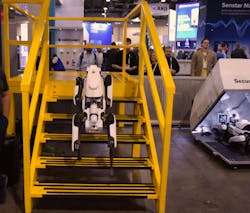This article originally appeared in the September 2023 issue of Security Business magazine. When sharing, don’t forget to mention Security Business magazine on LinkedIn and @SecBusinessMag on Twitter.
Though it may be hard to come to grips with, much of the security industry is in denial about the state of the video surveillance market. While industry observers and analysts continue to paint a relatively rosy picture as it pertains to overall demand for video solutions in the post-pandemic environment, the fact is, business paradigms for integrators are shifting as pricing competition between manufacturers continues to intensify.
This so-called “race to the bottom” – in which vendors now largely compete on price alone rather than on offering differentiated capabilities or feature sets – has essentially turned video cameras and other pieces of hardware into commodities. This trend has subsequently resulted in what seem to be ever-shrinking margins for the security channel; however, many integrators still rely on camera sales as the lifeblood of their businesses.
According to Security Business magazine’s own 2022 State of the Industry report, 77% of integrators polled reported that IP cameras were their top performing video surveillance product offering for the previous year with other product categories, including video management software (45%), video storage and playback (39%) and cloud/hosted video (31%) all performing at lower levels.
Additionally, the report found that hardware prices also continue to rise, as 46% of integrators noted that every manufacturing partner they worked with raised their equipment prices in 2022 compared to 2021, while another 34% said that between 75-99% of their vendors increased prices.
This combination of inflation-driven price hikes with increasing commoditization has created what seems to be an existential crisis for many integrators. As a result, some are now looking to cutting-edge or even what many would consider “bleeding-edge” technologies to create new revenue streams.
While some of these solutions hold a lot of potential for the market, others are still years away from becoming staple offerings in the physical security technology stack, and like other products, many will become commoditized and take integrators right back to where they are today.
A Closer Look: Bleeding Edge Technologies
Having come to manufacturing from the integration world, I understand the challenges many integrators see when they view software. Integrators are educated on physical hardware installation, and as a recent McKinsey study shows, they face the same challenge of many industries: retraining employees on AI.
Retraining from hardware to software deployment can be challenging in a world full of start ups that seem to change personnel and ownership often. Integrators face a challenge in learning where they exist in the new AI-based value chain and the need to keep the lights on and installers employed with physical hardware installation.
Here is a look at three of the more popular high-tech products that have gained traction in the industry recently, along with their potential promises and pitfalls.
LiDAR:
Having experienced a meteoric rise in popularity, LiDAR is one of the more interesting technologies with many potential applications in physical security. Short for “light detection and ranging,” LiDAR solutions leverage an array of lasers to measure reflected light off of objects and thus create a 3D model of an environment.
The technology, which really came to prominence via the automotive industry as EV manufacturers look for ways to make self-driving cars a reality, also has numerous security applications – particularly with regards to perimeter security and intrusion detection.
Additionally, because LiDAR only produces a three-dimensional model as opposed to a visible image, the technology has also been revered for how it addresses privacy concerns, as it can also be used to run many of the same analytics that have traditionally been performed by video, such as people counting. If video is a second set of eyes, in many ways, LiDAR is feeling in the dark with your hands.
While LiDAR may serve as a useful tool to augment an organization’s security operations, it was never intended to outright replace video surveillance or other security systems.
By definition, LiDAR does not have the ability to “see,” so the use cases for the tech beyond identifying objects and their distance from a protected area are fairly limited. And while the costs for LiDAR sensors have come down a bit from when they initially hit the market several years ago, they are still not at where they need to be to promote more widespread adoption throughout the industry.
Within the EV market, the popularity of LiDAR has begun to wane; in fact, a recent report from market research firm IDTechEx says the market share of LiDAR in the robotics industry is expected to decrease from 24% to 21% over the next decade. That said, the market share for cameras is expected to increase by 3%.
That’s not to say that the security industry should not look for innovative ways to use LiDAR and other emerging technologies; however, don’t look at them as a lifeline for your business.
Robotics:
One of the more controversial technologies to take security by storm recently are robotics – both the UAV (unmannedThe benefits of such solutions are straightforward: Robotics can serve as an immediate force multiplier for organizations, operating around-the-clock in a wide range of environments. Although they were initially billed as outright guard replacements, many see robots as an effective tool for performing so-called “dirty, dangerous and dull” jobs that manned guarding is not well-suited for.
However, beyond the “wow factor,” robotics has yet to fully prove itself as a dependable technology for security end-users. Aside from instances of robots in the field not performing as they were intended, many have also panned these solutions as another form of AI job-killer.
Furthermore, many of these robots are sold “as a service” directly by the vendor and have subsequently removed integrators from the value chain. There will undoubtedly be more applications for robotics in security as the technology becomes more mature, but that day is still too far out for integrators that need to boost their margins today.
Edge Processing:
For as long as IP has been the dominant camera technology, there has been a desire among both integrators and end-users to push more functionality to the edge. The rationale for this is sound: the more processing that can be done at the edge means there is less infrastructure, such as specialized servers and other appliances, which is needed for video surveillance deployments thus resulting in lower cost installs (read more about this trend in this article from Hailo's Yaniv Iarovici).
However, while the industry continues to make great strides in improving edge capabilities, the fact is, processing at the edge cannot currently provide the same reliability and performance of server-based infrastructure. The ability to process high-definition images in tandem with other data-intensive applications like AI-powered analytics inside of cameras themselves is still years away from becoming a reality.
As such, any large-scale move to the edge on the part of end-users or integrators at this point may be an exercise in futility. In fact, in many ways, integrators have removed much of their value in installing and maintaining servers and NVRs in the early adoption of the edge.
AI: Another Path to Profits
Where should integrators turn to improve their profitability in the absence of these and other new security tech innovations? The answer is relatively simple: invest in targeted employee retraining to leverage existing infrastructure and upsell customers on AI-based add-on solutions and services.
The advent of video analytics aided by modern machine learning and neural network training methodologies means that end-users have a variety of reliable, high-trust algorithms at their disposal to track just about everything they would ever want to know about their environment. From detecting and classifying people, objects and vehicles to determining whether workers are wearing the proper personal protective equipment (PPE), such as hardhats and safety vests, there are myriad analytics available and in high demand as organizations adjust to reality of the post-pandemic return-to-office landscape.
Even integrators themselves are expressing an increasing interest in adding analytics to their repertoire. More than half of the integrators surveyed (56%) in the 2022 Security Business State of the Industry survey said they had a strong interest in adding AI-based technologies to their product offerings.
While LiDAR and robotics are niche products, as the previously mentioned McKinsey study shows, most businesses have now adopted some form of AI. Integrators should look to align their experience and expertise in vertical markets with AI companies which match their verticals.
Many integrators make the mistake of bringing on as many AI solutions as possible, trying a spaghetti-on-the-wall approach and seeing what sticks, while the McKinsey study shows that those who specialize will find more success. Instead of having 10 different solutions, integrators should lean into their years of hard-earned expertise and, like other industries, retrain and reskill installers on AI, which could serve as a new, life-preserving revenue stream for integrators willing to leverage their experience to be their customers reliable partner in this new world of technology.
About the Author

Matt Powell
Managing Director for North America at ISS (Intelligent Security Systems)
Matt Powell is Managing Director for North America at ISS (Intelligent Security Systems), a pioneer and leader in the development of video intelligence and data awareness solutions. He has over two decades of experience in security and transportation technologies having formerly served as Principal-Infrastructure Markets at systems integrator Convergint and as a developer of transportation market strategies for Videolarm and Moog prior to that. He can be reached at [email protected].



